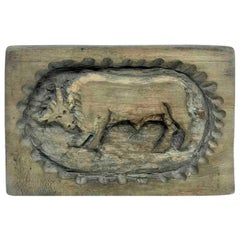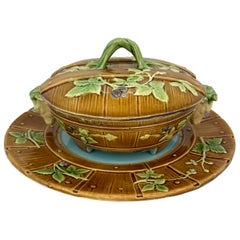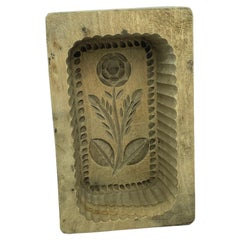Antique Butter Mold
Antique Late 19th Century Austrian Folk Art Sculptures and Carvings
Wood
Recent Sales
Antique 19th Century English Victorian Ceramics
Majolica
Antique 1890s Austrian Folk Art Sculptures and Carvings
Wood
Antique Early 1900s Austrian Folk Art Sculptures and Carvings
Wood
Antique Mid-19th Century Austrian Folk Art Sculptures and Carvings
Wood
Antique 1890s Austrian Folk Art Sculptures and Carvings
Wood
Antique 1890s Austrian Folk Art Sculptures and Carvings
Wood
Vintage 1910s Austrian Folk Art Sculptures and Carvings
Wood
Antique 1890s Swedish Folk Art Sculptures and Carvings
Wood
People Also Browsed
2010s Danish Scandinavian Modern Dining Room Chairs
Oak
21st Century and Contemporary Other Art Style Figurative Sculptures
Bronze
Mid-20th Century Swedish Scandinavian Modern Lounge Chairs
Fabric, Velvet, Birch
21st Century and Contemporary Mexican Mid-Century Modern Table Lamps
Wood, Fabric, Linen, Fiberglass
2010s British Scandinavian Modern Ottomans and Poufs
Velvet, Mohair, Oak
21st Century and Contemporary American Fireplaces and Mantels
Iron
21st Century and Contemporary Indonesian Modern Benches
Leather, Teak
21st Century and Contemporary Asian Country Benches
Wood
2010s Mexican Modern Desks and Writing Tables
Wood
21st Century and Contemporary American Spanish Colonial Console Tables
Iron
2010s Portuguese Mid-Century Modern Armchairs
Upholstery, Velvet, Wood
21st Century and Contemporary Other Art Style Figurative Sculptures
Bronze
Late 20th Century Uzbek Suzani Textiles
Wool
Antique Early 19th Century Greek Grand Tour Wall-mounted Sculptures
Marble, Statuary Marble
Vintage 1960s French Garden Ornaments
Concrete
Antique 19th Century Swiss Black Forest Animal Sculptures
Wood
A Close Look at Folk Art Furniture
Folk art is a genre of art that shares the creator’s traditions, offering not just an artistic display but an opportunity to learn about a culture. Antique, new and vintage folk art typically reflects a heritage or location. It can include utilitarian objects and handmade art as diverse as weather vanes, duck decoys, portraiture and paintings, carnival art and quilts.
Quilts are a quintessential part of American folk art but their roots are international, with quilting dating back to Ancient Egypt. The practice spread to Europe and was especially prominent in the Middle Ages, with one of the oldest surviving examples being the Tristan quilt made in Sicily in the 14th century. They were made as bedcovers and clothing, including as a layer for knights to wear beneath their armor. Native American folk art includes functional objects reflecting their heritage, such as baskets, textiles and wooden pieces.
Elsewhere, the vast range of work associated with Mexican folk art includes masks made by Mexican craftspeople for traditional celebrations and ceremonial dances. Mexican masks are part of the country’s folk-art traditions that go back thousands of years and play a role in festivals and theater.
Works in the folk art tradition are valuable because of the skills involved, like weaving, hand-carving wood and even stonework. Many folk artists are self-taught, while some train as apprentices within their community. By using available materials and taking a personal approach to their creations, artists ensure each piece is unique and conveys a story.
During the Great Depression, artistic materials in America were hard to come by, so artisans used discarded wood from cigar boxes and shipping crates to make highly stylized, notched pieces — most often picture frames and boxes — that are today sought after by collectors. This folk art style is called tramp art and was popular from roughly 1870 until the 1940s.
Folk art brings vibrant culture and traditions into your home. Browse an extensive collection of antique, new and vintage folk art on 1stDibs.
Finding the Right Folk Art for You
Folk art refers to a genre of art that shares the creator’s traditions, offering not just an artistic display but an opportunity to learn about a culture. Vintage, new and antique folk art typically reflects a heritage or location. It can include utilitarian objects and handmade art as diverse as weather vanes, portraiture and paintings, carnival art, quilts and duck decoys.
American folk art is frequently valued because of the traditional skills involved, like weaving, hand-carving wood and even stonework. Many folk artists are self-taught, while some train as apprentices within their community. By using available materials and taking a personal approach to their creations, artists ensure each piece is unique and conveys a story. Native American folk art includes functional objects reflecting their heritage, such as baskets, textiles and wooden pieces.
During the Great Depression, artistic materials in America were hard to come by, so artisans used discarded wood from cigar boxes and shipping crates to make highly stylized, notched pieces — most often picture frames and boxes — that are today sought after by collectors. This folk art style is called tramp art and was popular from roughly 1870 until the 1940s.
Folk art brings vibrant culture and traditions into your home. Browse an extensive collection of folk art on 1stDibs.


